You also want an ePaper? Increase the reach of your titles
YUMPU automatically turns print PDFs into web optimized ePapers that Google loves.
Grimm Grammar<br />
At home please read the<br />
following grammar point<br />
on the Grimm Grammar<br />
website.<br />
possessive determiners:<br />
accusative<br />
Example: die<br />
Großmutter/der Jäger<br />
In this example we’re<br />
trying to show how die<br />
Großmutter is related to<br />
der Jäger.<br />
We select the pronoun<br />
based on the gender<br />
of the person whose<br />
relation is being<br />
described (i.e., der<br />
Jäger → his (sein)).<br />
Then we need an<br />
ending based on the<br />
gender of the actual<br />
relation (i.e., die<br />
Großmutter → female<br />
(e)).<br />
Thus we have sein + e<br />
= seine.<br />
→ Die Großmutter ist<br />
seine Freundin.<br />
COERLL - Germanic Studies - First Year German<br />
Aktivität 11. Grimmige Familien<br />
In Grimm Grammar, you have met many a family, some not as “traditional” as<br />
others. Can you describe the relationships between the following (groups of)<br />
individuals?<br />
A. Wer ist wer?<br />
Describe the relationships among the various Grimm characters and replace the underlined words<br />
with the appropriate personal pronouns in the nominative case. Specifically, describe how the<br />
person on the left of the slash is related to the person on the right of it.<br />
Beispiel:<br />
Kapitel 5<br />
Rotkäppchen — die Großmutter Rotkäppchen ist ihr Enkelkind.<br />
Aschenputtels Stiefmutter — Aschenputtels Vater Die Stiefmutter ist seine Frau.<br />
1. die böse Königin — Schneewittchen<br />
2. Rotkäppchen — die Mutter<br />
3. Hänsel — Gretel<br />
4. Schneewittchen — der Königssohn<br />
5. sechs Zwerge — Happy<br />
6. Aschenputtel — die Stiefschwestern<br />
7. der Froschkönig — die Prinzessin<br />
8. die Großmutter — der Jäger (?)<br />
B. Wer tut was?<br />
Complete the sentences with the correct substitution for the underlined people (and animal).<br />
1. Aschenputtels Vater versteht Aschenputtels Stiefmutter nicht. ihre Stiefschwestern<br />
2. Rotkäppchen besucht die Großmutter. ihn<br />
3. Die böse Königin hasst Schneewittchen. ihre Großmutter<br />
4. Rotkäppchen liebt die Mutter. seine Schwester<br />
5. Hänsel beschützt (protects) Gretel. ihre Mutter<br />
6. Schneewittchen heiratet den Prinzen. ihre Stiefmutter<br />
7. Die sechs Zwerge suchen Happy. ihren Bruder<br />
8. Aschenputtel vermeidet (avoids) die Stiefschwestern. ihren Geliebten<br />
9. Die Prinzessin küsst den Froschkönig. sie<br />
Achtung! Obwohl Achenputtel und Schnewwitchen eigentlich grammatikalisch Neutrum<br />
(“das”) sind, benutzt man die Possessivpronomen oft in Referenz zum biologischen<br />
Geschlecht der Person, also hier weiblich.<br />
Page 216 of 484 CC 2013 University of Texas at Austin


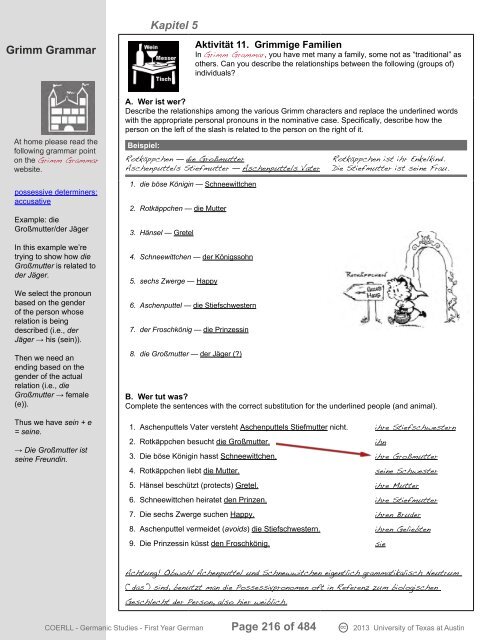
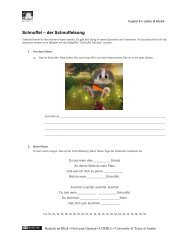
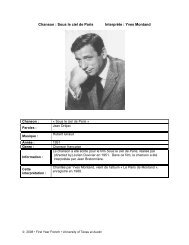
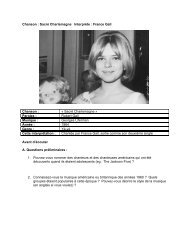


![con_02: negation [pdf]](https://img.yumpu.com/17488001/1/190x245/con-02-negation-pdf.jpg?quality=85)
![cas_04: telling time [pdf] - COERLL](https://img.yumpu.com/17487999/1/190x245/cas-04-telling-time-pdf-coerll.jpg?quality=85)
![v_04: separable prefix verbs [pdf]](https://img.yumpu.com/17487925/1/190x245/v-04-separable-prefix-verbs-pdf.jpg?quality=85)
![adj_01: adjectives overview, adjective endings [pdf]](https://img.yumpu.com/17487923/1/190x245/adj-01-adjectives-overview-adjective-endings-pdf.jpg?quality=85)
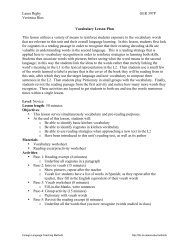
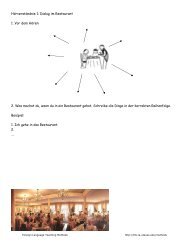
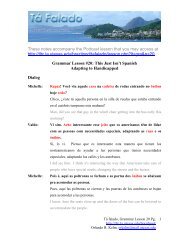
![vinf_01: infinitive constructions [pdf]](https://img.yumpu.com/17410532/1/190x245/vinf-01-infinitive-constructions-pdf.jpg?quality=85)
![cas_02: nominative case [pdf] - COERLL](https://img.yumpu.com/17410528/1/190x245/cas-02-nominative-case-pdf-coerll.jpg?quality=85)
![vi_09: schlafen [pdf] - COERLL](https://img.yumpu.com/17410520/1/190x245/vi-09-schlafen-pdf-coerll.jpg?quality=85)